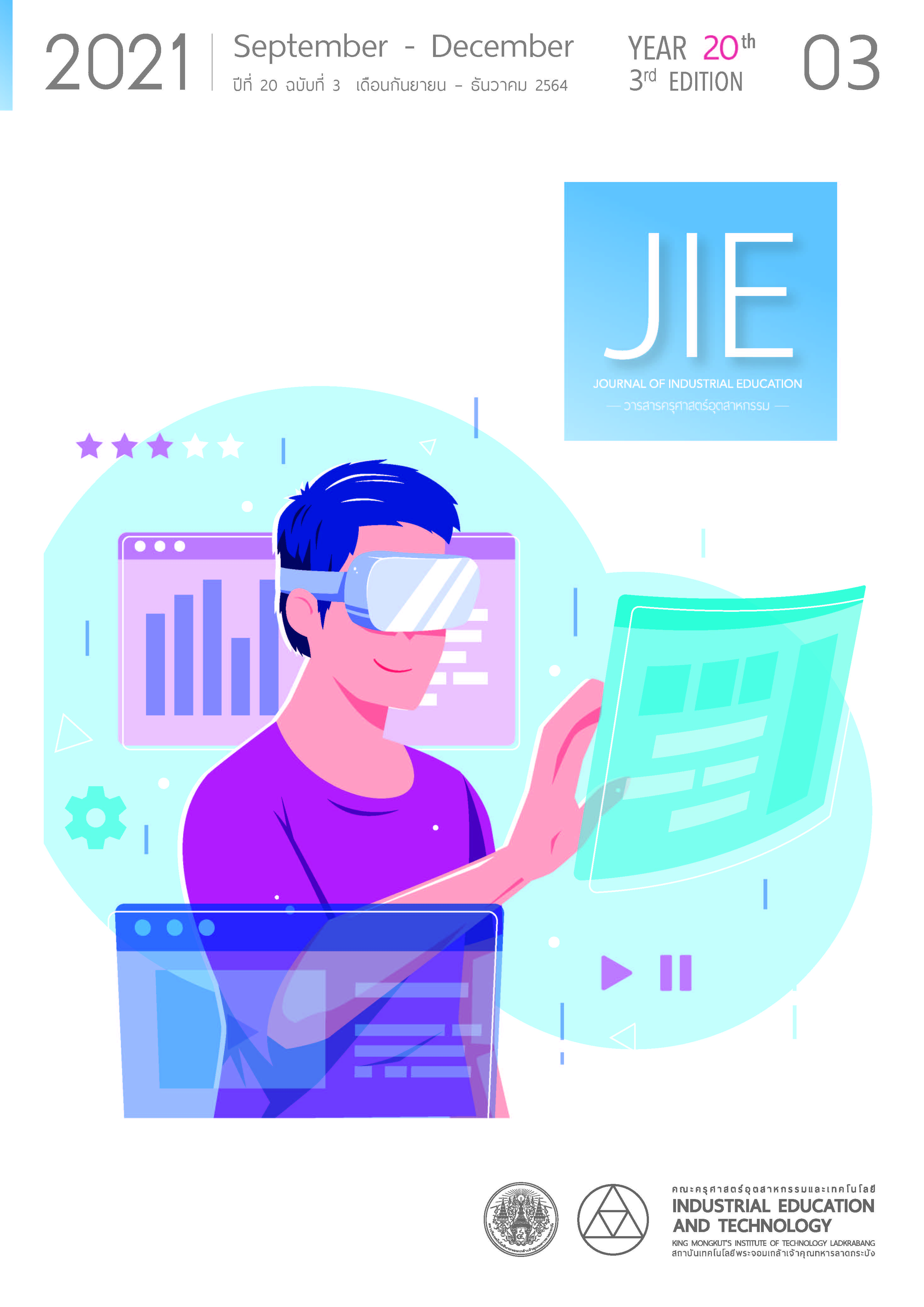รูปแบบกิจกรรมการสร้างประติมากรรมตัวละครดิจิทัลสำหรับนักศึกษาระดับปริญญาบัณฑิต
Main Article Content
บทคัดย่อ
การวิจัยนี้มีวัตถุประสงค์เพื่อศึกษากระบวนการสร้างประติมากรรมตัวละครดิจิทัลสำหรับนักศึกษาระดับปริญญาบัณฑิต และนำเสนอรูปแบบการจัดกิจกรรมการสร้างประติมากรรมตัวละครดิจิทัลสำหรับนักศึกษาระดับปริญญาบัณฑิต กลุ่มตัวอย่างประกอบด้วย นักศึกษาระดับปริญญาบัณฑิต จำนวน 45 คน ในรายวิชาคอมพิวเตอร์กราฟิก 3 มิติ จาก 2 สถาบัน ผู้เชี่ยวชาญด้านการออกแบบและสร้างสรรค์ตัวละครดิจิทัล จำนวน 7 คน และอาจารย์ผู้สอนประติมากรรมตัวละครดิจิทัล จำนวน 7 คน โดยเป็นการเลือกแบบเจาะจงตามเกณฑ์ที่กำหนด เครื่องมือที่ใช้ในการวิจัยประกอบด้วย 1) แบบสังเกตการสอนวิชาที่เกี่ยวข้องกับคอมพิวเตอร์กราฟิก 3 มิติ 2) แบบสอบถามกระบวนการสร้างและวิธีการสอนประติมากรรมตัวละครดิจิทัล และ 3) แบบสัมภาษณ์แบบมีโครงสร้าง สถิติที่ใช้ในการวิจัย ได้แก่ ค่าเฉลี่ย ส่วนเบี่ยงเบนมาตรฐาน และค่าร้อยละ ผลการวิจัยพบว่า 1) การจัดการเรียนการสอนประติมากรรมตัวละครดิจิทัล มีการวางลำดับเนื้อหาการสอนที่ครอบคลุม ใช้สื่ออุปกรณ์ประกอบการสอนที่เหมาะสมเน้นปฏิบัติการสอนที่ส่งผลต่อการสร้างชิ้นงานของผู้เรียนและความร่วมมือของผู้เรียน 2) กระบวนการสร้างประติมากรรมตัวละครดิจิทัลของผู้เชี่ยวชาญ เน้นทักษะพื้นฐานทางศิลปะ การพัฒนาแนวความคิดตลอดจนการร่างแบบ การวิเคราะห์สัดส่วน และการคำนึงถึงผลงานสำเร็จก่อนสร้างชิ้นงานจนเกิดเป็นเอกลักษณ์เฉพาะตัวที่เหมาะสมอยู่ในระดับมาก มีค่าเฉลี่ย ( = 3.74) ส่วนเบี่ยงเบนมาตรฐาน (S.D. = 0.75) และ 3) กระบวนการสอนสร้างประติมากรรมตัวละครดิจิทัลของอาจารย์ผู้สอน มีการออกแบบแบบร่างที่เน้นความเข้าใจโครงสร้างสัดส่วน สร้างผลงานตามความถนัดของตนเอง เน้นความเข้าใจและจดจำคำสั่งงานเพื่อมิให้เป็นข้อจำกัดต่อความคิดสร้างสรรค์และจินตนาการอยู่ในระดับมาก มีค่าเฉลี่ย (
= 3.68) ส่วนเบี่ยงเบนมาตรฐาน (S.D. = 0.81)
Article Details

This work is licensed under a Creative Commons Attribution-NonCommercial-NoDerivatives 4.0 International License.
"ข้อคิดเห็น เนื้อหา รวมทั้งการใช้ภาษาในบทความถือเป็นความรับผิดชอบของผู้เขียน"
References
Office of the Education Council. (2017). The National Scheme of Education B.E. 2017–2036. [online]. Available: http://www.onec.go.th/index.php/page/view/Outstand/2532 Retrieved July 10, 2021.
Songkram, N. (2013). Creating Innovators : Change learners into innovators. Bangkok: Chulalongkorn University. 24-32. (in Thai)
Wongyai, W. (2011). Development of higher education curriculum. 2nd ed. Bangkok: R&P Print. 39-43. (in Thai)
Suselo, T., Wunscke, B., & Reilly, A. L. (2017). The Journey to improve teaching computer graphic : A systematic review. [online]. Available: https://www.researchgate.net/publication/326147819_The_Journey_to_Improve_Teaching_Computer_Graphics_A_Systematic_Review Retrieved July 10, 2021.
Hattal, B. M., Connell, K. O., & Sokolove, D. (2012). Guidelines for curricula in computer graphics in the visual arts. [online]. Available: https://education.siggraph.org/archive/past-projects/art/guidelines-1990 Retrieved July 14, 2021.
Alley, T. (2014). Computer graghics knowledge base report. [online]. Available: https://education.siggraph.org/resources/knowledge-base/report Retrieved June 10, 2021.
Department of International Trade Promotion, Ministry of Commerce, THAILAND. (2019). Business Character. [e-book]. Available: https://www.ditp.go.th/ditp_web61/article_sub_view.php?filename=contents_attach/211770/211770.pdf&title=211770&cate=1133&d=0 Retrieved July 23, 2021.
Thai animation and computer graphics association. (2020). TACGA news & event. [e-book]. Available: http://www.tacga.or.th/news-events/ Retrieved July 23, 2021.
Crossley, K. (2014). Character Design From The Ground Up. United Kingdom: ILEX. 72-120.
Burdek, B. E. (2015). Design : History, Theory and Practice of Product Design. 2nd ed. Germany: Birkhauser. 108-113.
3dtotalPublishing. (2018). Beginner’s guide to Zbrush. United Kingdom: Gomar Press. 15-182.
Panmanee, A. (2003). Creative psychology of teaching. Bangkok: Y M Creative. 12-79. (in Thai)
Glickman, C. D., Gordon, S. P., & Ross-Gordon, J. M.C. (2010). Super Vision and Instructional Leadership: A Developmental Approach. Boston: Pearson. 108-119.
Norman, D. (1984). Software Engineering for User Interfaces. Carnegie Mellon University: Allen Newell Collection. 59-106.
Rivers, A., Durand, F., & Igarashi, T. (2010). “3D modeling with silhouettes.” ACM Transactions on graphics. 29(4), 109.
Lee, J., Ahn, J., Kim, J., Kho, J. M., & Paik, H. Y. (2018). “Cognitive evaluation for conceptual design: comgnitive role of a 3D sculpture tool in the design thinking process.” Digital Creativity. 29(4), 299-314.
Sloan, R. J.S. (2015). Virtual character design : for games and interactive media. Boca Raton: CRC Press LLC. 4-50.
Kumpai, K., Kusirirat, K., & Wata, A. (2020). “Results of character design activities from playing computer games to enhance 3D character design skills in 3D animation courses.” RMUTSB Acad. Journal (Humanities and social sciences). 5(2), 269-282. (in Thai)
Lopez, C., Pena, J. A., & Miralbes, R. (2019). “3D organic modeling using hybrid techniques with polygons.” In L. Luo, (Eds). Temporal Modelling of Customer Behaviour, Switzerland: Springer International Publishing. 263-271.
Copyright Acts. (1994). Licensing. [e-book]. Available: http://www.fio.co.th/south/law/8/85.pdf Retrieved July 23, 2021.
Boonsinsuk, U. (2019). “Character licensing and the digital path to monetization. Case studies from Thai creators.” Executive Journal. 39(1), 12-23. (in Thai)
Artstation. (2021). Digital Product. [online]. Available: https://www.artstation.com/marketplace/game-dev Retrieved July 25, 2021.
Thairath online. (2021). NFT. [online]. Available: https://www.thairath.co.th/lifestyle/tech/2099661 Retrieved July 26, 2021.

